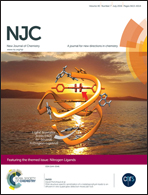A Co(ii) complex of a vitamer of vitamin B6 acts as a sensor for Hg2+ and pH in aqueous media†
Abstract
A Co(II) complex of molecular formula C48H96.8N12O22.4Co2Cl2, 1, was synthesized from the Schiff base [H2pydmdp]Cl by a template reaction of pyridoxal (pyd), a vitamer of vitamin B6, N-methyl-1,3-diaminopropane (mdp) and cobalt(II) acetate. It was characterized by elemental analysis, 1H NMR, IR and UV-Vis spectroscopy, thermal analysis, electrochemistry and single crystal X-ray diffraction. The experimental results suggested that in complex 1, the central Co(II) is bonded to two phenolato-oxygens, two imine nitrogens and two amine nitrogens in an octahedral geometry. In aqueous media complex 1 exhibits an intense fluorescence emission peak at 506 nm when it was excited at 425 nm. The fluorescence behavior of complex 1 in aqueous media was employed to determine whether it acts as a chemosensor for some selective toxic metal ions. The studies showed that the present complex behaves as a promising sensor for Hg2+ even at the sub-micromolar level. In addition in aqueous solution, complex 1 acts as a sensor for the pH of the medium. A detailed study on the mechanism of sensing behavior established that Hg2+ interacts with complex 1 via weak non-covalent interaction with the N-atom of the pyridine moiety of the molecule. The pyridine nitrogen also plays a vital role in sensing the pH of the medium.


 Please wait while we load your content...
Please wait while we load your content...